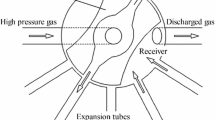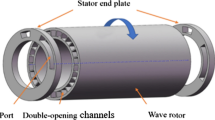Abstract
This paper introduces the refrigeration cycle process of the gas wave oscillation tube (GWOT). Aiming at the problem that the strong reverse compression waves generated during the refrigeration process affect the performance, this paper proposes a variable-section GWOT that weakens the reverse compression waves and a variable-section structure designed using a numerical method. Results showed that the variable-section structure could reduce the intensity of the incident shock wave by approximately 7% and the total entropy production in the refrigeration cycle by approximately 8% under the design condition. Moreover, the variable-section structure can effectively weaken the strength of the reverse compression waves and improve the refrigeration efficiency by approximately 4% under the same working conditions. The variable-section structure can also widen the high-performance working range of the GWOT. The experimental results reveal that the high-performance working range can be expanded by more than two times under the design condition. The research can guide the subsequent development of gas wave refrigeration technology and a reference for other wave rotor application technologies.
Similar content being viewed by others
References
Resler Jr. E L, Mocsari J C, Nalim M R. Analytic design methods for wave rotor cycles. J Propulsion Power, 1994, 10: 683–689
Gu C, Tang J B, Wang J J, et al. Advance in research of several types of streaming of pulse tube refrigerators. Sci China Tech Sci, 2013, 56: 2690–2701
Jia G W, Cai M L, Xu W Q, et al. Energy conversion characteristics of reciprocating piston quasi-isothermal compression systems using water sprays. Sci China Tech Sci, 2018, 61: 285–298
Shi Y, Chang J, Zhang Q, et al. Gas flow measurement method with temperature compensation for a quasi-isothermal cavity. Machines, 2022, 10: 178
Akbari P, Nalim R, Mueller N. A review of wave rotor technology and its applications. J Eng Gas Turbines Power, 2006, 128: 717–735
Akbari P, Nalim M R. Review of recent developments in wave rotor combustion technology. J Propulsion Power, 2009, 25: 833–844
Hu D, Li R, Liu P, et al. The design and influence of port arrangement on an improved wave rotor refrigerator performance. Appl Thermal Eng, 2016, 107: 207–217
Akbari P, Nalim R, Müller N. Performance enhancement of microturbine engines topped with wave rotors. J Eng Gas Turbines Power, 2006, 128: 190–202
Nalim R, Pekkan K. Internal combustion wave rotors for gas turbine engine enhancement. In: Proceedings of the International Gas Turbine Congress. Tokyo, 2003
Nalim M R. Longitudinally stratified combustion in wave rotors. J Propulsion Power, 2000, 16: 1060–1068
Okamoto K, Nagashima T. Visualization of wave rotor inner flow dynamics. J Propulsion Power, 2007, 23: 292–300
Ruan C, Chen F E, Yu T, et al. Experimental study on impacts of fuel type on thermo-acoustic instability in a gas turbine model combustor. Sci China Tech Sci, 2021, 64: 1345–1358
Tüchler S, Copeland C D. Experimental and numerical assessment of an optimised, non-axial wave rotor turbine. Appl Energy, 2020, 268: 115013
Tao S, Dai Y, Zou J, et al. Characteristics of static pre-cyclonic steam ejector. Int J Thermal Sci, 2017, 120: 244–251
Liu P, Feng M, Liu X, et al. Performance analysis of wave rotor based on response surface optimization method. J Energy Resources Tech, 2022, 144: 061302
Hu D, Wang J, Wu M, et al. Unsteady heat transfer between gas and tube in a wave rotor refrigerator. J Thermal Sci Eng Appl, 2020, 12: 054502
Liu Y G, Gao X H, Cheng N N. Performance analysis and design of self-air-cooling reciprocating compressor’s cooling system. Sci China Tech Sci, 2020, 63: 2631–2639
Folley M, Peñate Suarez B, Whittaker T. An autonomous wave-powered desalination system. Desalination, 2008, 220: 412–421
Mayer A, Oda J, Kato K, et al. Extruded ceramic—A new technology for the Comprex® rotor. In: SAE International Congress and Exposition. SAE Paper 890453, 1989
Berchtold M. The Comprex® proceeding ONR/NAVAIR wave rotor research and technology workshop. Naval Postgraduate School, Monterey, CA, 1985. 50–74
Zheng X Q, Zhang Y J, Yang M Y. Research and development on transonic compressor of high pressure ratio turbocharger for vehicle internal combustion engines. Sci China Tech Sci, 2010, 53: 1817–1823
Fatsis A, Ribaud Y. Thermodynamic analysis of gas turbines topped with wave rotors. Aerosp Sci Tech, 1999, 3: 293–299
Fatsis A. Gas turbine performance enhancement for naval ship propulsion using wave rotors. J Mar Eng Tech, 2022, 21: 297–309
Ma X Q, Su Z T. Development of acoustic liner in aero engine: A review. Sci China Tech Sci, 2020, 63: 2491–2504
Wilson J. Design of the NASA law is 4-Port wave rotor experiment. AIAA Paper 97–3139, 1997
Kentfield J A C. Wave rotors and highlights of their development. AIAA Paper 98–3248, 1998
Kharazi A A, Akbari P, Müller N. Preliminary study of a novel R718 compression refrigeration cycle using a three-port condensing wave rotor. J Eng Gas Turbines Power, 2005, 127: 539–544
Liu P, Zhu Y, Wang H, et al. Influence of the nozzle angle on refrigeration performance of a gas wave refrigerator. Shock Waves, 2017, 27: 507–516
Li J, Gong E, Yuan L, et al. Experimental investigation on pressure rise characteristics in an ethylene fuelled wave rotor combustor. Energy Fuels, 2017, 31: 10165–10177
Hu D, Zhao Y, Wu T, et al. The experimental research and mechanism analysis on the influence of wave rotor rotational speed on the wave system and flow losses of gas wave ejector. Chem Eng Process-Process Intensif, 2019, 144: 107638
Snyder P H. Enhanced pressure wave supercharger system and method thereof. US Patent. 10724450B2. 2018-01-18
Emmerson C W. Exhaust mixer for wave rotor. US Paper 2016/0230656, 2016
Liu P, Wu K, Liu S, et al. Mechanism analysis of weakening reverse compression waves in gas wave refrigerator. J Thermal Sci Eng Appl, 2018, 10: 061013
Liu P, Li X, Liu X, et al. Investigation of the shock wave formation and intensity in wave rotor. J Energy Resources Tech, 2021, 143: 111301
Zullah M A, Prasad D, Ahmed M R, et al. Performance analysis of a wave energy converter using numerical simulation technique. Sci China Ser E-Tech Sci, 2010, 53: 13–18
Kock F, Herwig H. Local entropy production in turbulent shear flows: A high-Reynolds number model with wall functions. Int J Heat Mass Transfer, 2004, 47: 2205–2215
Author information
Authors and Affiliations
Corresponding author
Additional information
This work was supported by the National Key Research and Development Program of China (Grant No. 2018YFA0704601), the National Natural Science Foundation of China (Grant No. 22078040), and the Fundamental Research Funds for the Central Universities (Grant No. DUT22LAB604).
Rights and permissions
About this article
Cite this article
Wang, H., Liu, X., Fu, Z. et al. Numerical and experimental study on the refrigeration performance of a variable-section gas wave oscillation tube. Sci. China Technol. Sci. 66, 489–500 (2023). https://doi.org/10.1007/s11431-022-2180-7
Received:
Accepted:
Published:
Issue Date:
DOI: https://doi.org/10.1007/s11431-022-2180-7




